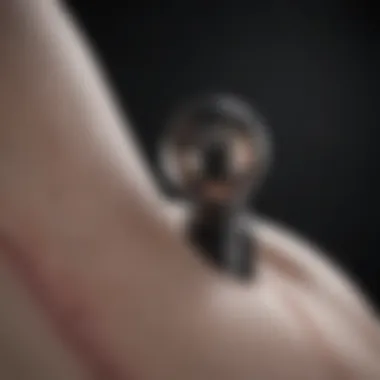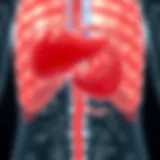Contrast Ultrasound: Techniques and Applications


Intro
Contrast ultrasound is an advanced imaging modality that significantly augments the diagnostic power of traditional ultrasound. This technique employs microbubble contrast agents, enhancing the visualization of blood flow and vessel structures. The use of contrast agents allows for improved differentiation of tissues, providing detailed insights critical for clinical decision-making.
The relevance of contrast ultrasound extends across various medical fields, including cardiology, oncology, and obstetrics. With its non-invasive nature, it presents an attractive alternative to other imaging techniques such as CT and MRI, which may involve exposure to radiation. As the healthcare landscape evolves, the demand for effective diagnostic tools continues to rise, making the exploration of contrast ultrasound both timely and necessary.
In this article, a comprehensive review of contrast ultrasound will be presented. Key sections will address the underlying principles of the technology, its advantages and limitations, as well as its practical applications in clinical settings.
Prelude to Contrast Ultrasound
Contrast ultrasound has emerged as a vital imaging technique used in various medical fields. This approach significantly enhances the diagnostic capabilities compared to conventional ultrasound. Through the use of microbubble contrast agents, it enables clinicians to visualize vascular structures and perfusion in real-time, facilitating clearer assessments of conditions that may not be easily detectable with standard ultrasound.
The importance of understanding contrast ultrasound lies not only in its applications but also in how it complements other imaging modalities. Its capacity to offer dynamic and functional information about tissue perfusion sets it apart from traditional imaging methods. The integration of contrast agents helps address certain limitations associated with conventional ultrasound, such as insufficient detail or lack of contrast in specific examinations.
Definition and Purpose
Contrast ultrasound refers to an imaging technique that incorporates the use of contrast agents to improve the visualization of vascular structures and enhance the overall quality of ultrasound images. The primary purpose of employing contrast agents is to increase the echogenicity of blood or certain tissues, thereby providing clearer images during examinations.
These agents are typically composed of microbubbles that are suspended in a liquid. When injected into the bloodstream, they produce a strong echogenic signal, which allows the ultrasound waves to reflect more effectively. This enhanced visibility is particularly useful in applications such as imaging of the heart, liver, and kidneys, where distinguishing between different tissue types and identifying blood flow is critical.
Historical Context
The origins of contrast ultrasound date back to the early 1990s when researchers first began exploring the use of contrast agents to improve the efficacy of conventional ultrasound imaging. Initial studies focused on creating stable microbubbles that could withstand the ultrasound environment without collapsing prematurely. Over the years, advancements in the technology and chemistry of these agents have contributed to a broader acceptance within the medical community.
Early applications were largely centered on cardiac imaging, as the need for evaluating heart conditions was increasing. As knowledge and technology progressed, the use of contrast ultrasound expanded, influencing various areas of diagnostics, including abdominal and vascular imaging. Today, it is recognized as a valuable complement to other imaging techniques, like MRI and CT, providing essential information that can enhance patient outcomes.
While the technique has evolved, understanding its roots in medical imaging remains crucial, as it sheds light on its growth and present-day applications. The ongoing research and development promise to shape the future of contrast ultrasound even further, making it an exciting area of study.
Fundamentals of Ultrasound Technology
In understanding contrast ultrasound, it is crucial to grasp the underlying principles of ultrasound technology. This foundational knowledge illuminates how contrast agents improve the typical ultrasound experience. Integrating these technologies enhances diagnostic capabilities in various medical fields, ultimately leading to better patient outcomes. The fundamentals cover the mechanics of sound waves, the types of imaging available, and the specific role of contrast agents. This creates a comprehensive view of how ultrasound functions and its potential applications.
Basic Principles of Ultrasound
Ultrasound imaging is based on sound waves emitted from a transducer, which then capture echoes reflecting off tissues and structures within the body. These sound waves travel at varying speeds through different mediums, resulting in different reflections. The transducer analyzes the echoes, converting them into a visual representation. The resulting images are in real-time, aiding clinicians in immediate assessments.
The interaction of sound waves with structures depends on several factors:
- Frequency of sound waves: Higher frequencies yield better resolution but penetrate less deeply. Conversely, lower frequencies reach deeper but with lower resolution.
- Acoustic impedance: This relates to how sound waves travel through varying types of tissue. Differences in impedance between tissues result in echoes.
- Doppler effect: This principle measures blood flow changes and movement within the body using frequency shifts.
The basic principles of ultrasound underpin all imaging practices today, serving as essential knowledge for healthcare professionals.
Types of Ultrasound Imaging
Several types of ultrasound imaging exist, each designed for specific diagnostic needs. The primary methods include:
- 2D Ultrasound: This traditional form produces flat, two-dimensional images, often utilized in obstetrics and gynecology.
- 3D Ultrasound: By capturing multiple two-dimensional images, 3D ultrasound creates a three-dimensional view, commonly used in fetal imaging.
- Doppler Ultrasound: This variant measures blood flow and velocity, essential for assessing vascular health.
- Contrast-enhanced ultrasound (CEUS): Involves the use of contrast agents to improve the definition and quality of the ultrasound images. It shows blood flow and perfusion more precisely than standard imaging methods.
Each type of ultrasound serves distinct purposes, and understanding these allows practitioners to choose the correct imaging method for specific clinical scenarios.
Contrast Agents in Ultrasound
Contrast agents are crucial for enhancing ultrasound images, facilitating better diagnostic interpretations. These agents are typically microbubbles filled with gas, which are designed to reflect ultrasound waves effectively. The primary advantages of using contrast agents include:
- Improved visibility of blood vessels and tissues: Contrast agents highlight structures that may not be adequately visualized with standard ultrasound, especially in complex anatomies.
- Assessment of perfusion and blood flow: They help evaluate vascular conditions and organ perfusion, leading to informed clinical decisions.
- Detection of lesions: These agents improve the characterization of tumors and identifying benign versus malignant growths.
In summary, contrast agents are not merely additives but integral components that transform the capabilities of ultrasound technology, enhancing its role in modern diagnostics.
"Contrast ultrasound offers a significant advancement in clinical imaging, helping to identify pathologies that traditional methods may miss."


Understanding these fundamentals provides a strong base for comprehending more advanced topics in contrast ultrasound technology and its wide-ranging applications.
Mechanisms of Contrast Enhancement
Understanding the mechanisms of contrast enhancement is crucial in the field of contrast ultrasound. This segment provides insight into how contrast agents work to improve imaging quality. By exploring the physical properties of these agents and their interaction mechanisms, we can appreciate their role in enhancing ultrasound visualization. The detailed examination of these elements reveals both the efficacy and considerations integral to the deployment of contrast ultrasound in various clinical scenarios.
Physical Properties of Contrast Agents
Contrast agents are specialized substances used to improve the clarity of ultrasound images. They possess unique physical properties that allow them to reflect ultrasound waves more effectively than surrounding tissues. Key factors include:
- Microbubble Composition: Most agents are composed of gas-filled microbubbles. These bubbles have an outer shell, generally made of a lipid or protein, that enhances stability and enables them to remain suspended in the blood.
- Size: The small size of microbubbles, typically ranging from 1 to 10 micrometers, is significant, allowing them to traverse through small blood vessels.
- Acoustic Characteristics: These agents have a high acoustic impedance, which means they reflect sound waves more strongly than tissue. This contrasts starkly with the surrounding soft tissue, enabling clearer images.
- Stability: The durability of microbubbles influences their circulation time in the bloodstream. Adequate stability ensures that the bubbles persist for long enough to provide an optimal imaging window.
These properties directly impact the visualization quality in ultrasound imaging, making it crucial for practitioners to select appropriate contrast agents based on their physical characteristics and the desired imaging outcomes.
Interaction Mechanisms
The interaction of contrast agents with ultrasound waves is pivotal for achieving enhanced imaging results. A few fundamental mechanisms are noteworthy:
- Reflection: When ultrasound waves encounter a microbubble, they are reflected back. The strong contrast between the gas in the bubble and surrounding tissue results in an amplified echogenic signal, which significantly improves image contrast.
- Resonance: At certain frequencies, microbubbles can resonate, producing nonlinear responses. This behavior can be harnessed to create stronger signals, further improving imaging efficacy. The tailored use of frequencies can enhance different tissue characteristics.
- Interaction with Blood Flow: Microbubbles flow with blood, allowing for real-time vascular imaging. Their passage through blood vessels provides dynamic insights into perfusion and can indicate vascular abnormalities or pathologies. This is particularly useful in assessing conditions such as tumors or myocardial perfusion.
"Understanding the mechanisms behind contrast agents not only enhances imaging but also informs their clinical applications and potential innovation."
Clinical Applications of Contrast Ultrasound
Clinical applications of contrast ultrasound have transformed the landscape of medical imaging. This technique enhances visualization in various specialties, aiding in diagnostic precision and allowing for better treatment decisions. The usefulness of contrast ultrasound extends beyond the capabilities of standard ultrasound, particularly in assessing structures that may not be adequately visualized due to limitations in resolution or contrast. With a growing awareness of its benefits, healthcare professionals are increasingly integrating this modality into routine practice.
Cardiac Imaging
Contrast ultrasound plays a pivotal role in cardiac imaging. It assists in evaluating cardiac structure and function through improved visualization of the heart’s chambers and blood flow. The use of contrast agents allows for a clearer distinction of blood and myocardial tissue, which is essential in cases where standard imaging may miss abnormalities.
Clinical scenarios where contrast ultrasound is particularly valuable include assessing cardiac masses, congenital heart disease, and myocardial perfusion. By enhancing echo signals, the technique also facilitates the detection of subtle changes in wall motion and ejection fractions, which are critical for diagnosing conditions such as heart failure or ischemia.
Abdominal Imaging
In abdominal imaging, contrast ultrasound aids in the diagnosis of liver diseases, gallbladder conditions, and renal pathologies. The contrast agents help differentiate between cystic and solid masses, providing clearer insights into lesions that might otherwise be indistinguishable in routine scans.
For example, in liver evaluations, contrast-enhanced ultrasound can effectively identify focal liver lesions and differentiate between hemangiomas and malignant tumors. This ability reduces the need for more invasive procedures, allowing for safer patient management. Moreover, by assessing blood flow to abdominal organs, clinicians can gather data on vascular integrity and organ perfusion, essential metrics for various pathological conditions.
Vascular Imaging
Vascular imaging is another area where contrast ultrasound proves invaluable. By enhancing blood flow visualization, it allows for detailed assessments of vascular conditions such as stenosis or thrombosis. These assessments are key in conditions like deep vein thrombosis or peripheral artery disease.
The use of contrast agents in vascular imaging can significantly improve the visualization of smaller vessels and their perfusion status. This enhanced detail greatly aids in preoperative planning and postoperative evaluations, leading to better clinical outcomes.
Oncological Applications
In oncology, contrast ultrasound has emerged as a useful tool for tumor characterization and follow-up assessments. Its efficacy lies in the ability to provide real-time observations of blood flow within tumors, thus offering crucial insights into tumor behavior.
Contrast ultrasound can aid in differentiating benign from malignant lesions, as malignant tumors generally exhibit more vascularity. Moreover, it is frequently employed to evaluate the response to therapies, guiding treatment decisions in real-time. This adaptability enhances the management of cancer patients, allowing for personalized approaches based on ongoing assessments of tumor dynamics.
Through these varied applications, contrast ultrasound continues to solidify its role as an essential tool in modern medicine, providing clinicians with critical information needed for accurate diagnosis and effective treatment.
Advantages of Contrast Ultrasound
The advantages of contrast ultrasound are critical in understanding its role in medical imaging. This modality is not merely an enhancement of traditional ultrasound; it significantly expands diagnostic capabilities and improves patient outcomes across various clinical settings.
Safety Profile
One of the most compelling advantages of contrast ultrasound is its favorable safety profile compared to other imaging techniques, such as magnetic resonance imaging (MRI) and computed tomography (CT). Traditional contrast agents often pose risks, such as allergic reactions or nephrotoxicity. In contrast, the contrast agents used in ultrasound, such as microbubble agents, have shown a low incidence of adverse events.
- Lower Risk of Allergies: Patients with a history of contrast allergies can often receive these agents without concern.
- No Ionizing Radiation: Unlike CT scans, contrast ultrasound does not utilize ionizing radiation. This trait is especially important for vulnerable populations, such as pregnant women and children.


The safety of patients remains paramount in medical imaging, and contrast ultrasound offers a promising alternative with fewer risks.
Enhanced Visualization
Enhanced visualization is another pivotal advantage of contrast ultrasound. These techniques allow clinicians to obtain clearer and more detailed images of blood flow, perfusion, and the functional parameters of organs. This trait enhances the detection and characterization of various medical conditions.
- Improved Diagnosis: Contrast ultrasound aids in accurately diagnosing conditions like myocardial ischemia and liver lesions.
- Dynamic Assessment: The real-time imaging capability allows for a dynamic assessment of vascularity and blood flow, which is crucial for various procedures.
- Better Differentiation of Lesions: The contrast agents improve the contrast-to-noise ratio, allowing better differentiation between benign and malignant lesions.
Cost Effectiveness
Cost-effectiveness is another essential aspect of utilizing contrast ultrasound. Because it generally requires less investment in terms of both the technology and its operational costs, healthcare facilities can implement contrast ultrasound more readily.
- Shorter Examination Time: Contrast ultrasound studies usually take less time to perform than MRI or CT, resulting in lower overhead costs.
- Reduced Need for Repeat Procedures: With improved visualization, fewer repeat procedures are necessary, minimizing costs associated with patient management.
- Accessibility: Facilities may find it easier and cost-effective to maintain ultrasound equipment, making contrast ultrasound more accessible for widespread use.
Limitations and Challenges
Understanding the limitations and challenges of contrast ultrasound is vital for practitioners and researchers in the field. Acknowledging these aspects helps to set realistic expectations and encourages further research and innovation. Limitations can affect diagnostic decisions and the overall effectiveness of this imaging modality in certain scenarios. It is essential for medical professionals to navigate these challenges to maximize patient care.
Technical Limitations
Despite the numerous benefits of contrast ultrasound, it is not without its technical challenges. One of the prominent issues is related to the resolution capabilities when imaging certain tissues or structures. Contrast agents are designed to enhance the visibility of blood flow; however, sometimes the agents may not provide adequate contrast in regions of high attenuation, leading to poor imaging quality.
In addition, artifacts can frequently occur, especially in patients with high body mass index or in specific anatomical regions, thus complicating the interpretation of the images. This situation demands skilled operators who can differentiate between genuine pathologies and imaging artifacts.
Furthermore, the availability of contrast agents can pose a challenge. Some agents are not universally available in all regions or institutions. This limitation can restrict the use of contrast ultrasound in clinical settings, particularly in less accessible or resource-limited environments.
Regulatory Concerns
Regulatory concerns are another factor that influences the implementation of contrast ultrasound in clinical practice. Regulatory approval for new contrast agents can be a lengthy and complex process. This complexity often delays the introduction of potentially beneficial products to the market. Regulatory bodies, such as the FDA, demand comprehensive data on safety and efficacy before approving new agents.
Moreover, there are ongoing concerns regarding safety and allergic reactions, which demand thorough investigation and guidelines from regulatory agencies. Healthcare providers must stay updated with evolving regulations and recommendations to ensure safe practices in their use of contrast ultrasound.
"Awareness of regulations and their implications can profoundly impact the proper application of contrast ultrasound in clinical settings."
In summary, while contrast ultrasound holds immense promise for enhancing diagnostic imaging, its limitations and challenges necessitate a careful approach. Addressing these technical hurdles and regulatory concerns will not only improve the accuracy and safety of the technique but also pave the way for future developments and innovations.
Future Directions in Contrast Ultrasound
The field of contrast ultrasound is evolving rapidly, pushing the boundaries of what is possible in medical imaging. This section underlines the importance of exploring future directions in this discipline. Understanding the innovations and integrations that lie ahead can significantly enhance the capabilities of clinicians in their diagnostic practices. It can lead to more accurate assessments, timely interventions, and ultimately better patient outcomes. Knowing what advancements are on the horizon will foster a greater appreciation of contrast ultrasound as a dynamic tool in the medical arsenal.
Innovations in Contrast Agents
One significant area of future development is the innovation in contrast agents. Traditionally, ultrasound contrast agents have consisted mostly of gas-filled microbubbles. Future innovations may involve creating agents with improved stability and enhanced echogenic properties.
- Nano-Technology: The use of nanoparticles could allow for more precise imaging at cellular levels.
- Targeted Agents: There is potential for developing agents that target specific tissues or biomarkers, improving diagnosis in areas like oncology.
- Biocompatibility: Advances in materials science will likely lead to the creation of more biocompatible contrast agents, reducing side effects and reactions.
These developments will not only enhance imaging quality but could also enable new applications in areas like molecular imaging and therapy.
Integration with Other Imaging Modalities
The future of contrast ultrasound also holds promise for greater integration with other imaging modalities. The synergistic effects of combining different technologies can result in comprehensive imaging strategies that leverage the strengths of each method.
- Hybrid Imaging: Merging ultrasound with techniques such as PET (Positron Emission Tomography) or MRI (Magnetic Resonance Imaging) could provide multi-dimensional insights into patient conditions.
- Real-Time Imaging: Integrative approaches may facilitate real-time imaging, allowing clinicians to make decisions based on immediate data.
- AI and Machine Learning: The incorporation of artificial intelligence into these imaging workflows will enable deeper analytics and more accurate interpretations.
By embracing a multi-modal approach, healthcare professionals can enhance diagnostic accuracy and improve patient care pathways.
Comparative Analysis with Other Imaging Techniques
The comparative analysis of contrast ultrasound with other imaging modalities such as MRI and CT scans is essential for understanding its role in medical diagnosis and treatment. This analysis helps in determining the suitability and advantages of contrast ultrasound in various clinical situations. By examining the differences between these imaging techniques, healthcare professionals can make informed choices that best serve patient needs.


Evaluating the efficacy, safety, and cost of different imaging techniques is critical to ensure that patients receive optimal care. Equally, the contrast ultrasound's unique properties can sometimes complement or enhance the limitations seen in MRI or CT. This comprehensive examination lays the groundwork for a deeper understanding of when and how contrast ultrasound can be the preferred imaging method, or when other modalities are more appropriate.
MRI vs. Contrast Ultrasound
Magnetic Resonance Imaging (MRI) is one of the most advanced imaging techniques available. Its ability to produce highly detailed images is well-known. MRI uses powerful magnets and radio waves to generate images of organs and tissues. On the other hand, contrast ultrasound employs specific agents to enhance the visibility of blood vessels and tissues during ultrasound examinations.
While MRI is excellent for imaging soft tissues, it has limitations in terms of accessibility and cost. Contrast ultrasound offers faster imaging, lower operational costs, and a better safety profile. Notably, because it uses sound waves, it avoids the ionizing radiation associated with MRI and CT scans, making it a safer option in many cases. However, it does not achieve the same level of detail for soft tissues as MRI does.
Consideration of the patient's specific clinical situation is critical. MRI may be preferred for neurological assessments, while contrast ultrasound can be suited for cardiovascular or abdominal applications.
Key Differences Include:
- Image Detail: MRI typically provides higher resolution images than contrast ultrasound.
- Safety: Contrast ultrasound has a better safety profile, particularly concerning radiation exposure.
- Cost and Availability: Generally, contrast ultrasound is more cost-effective and accessible in many healthcare settings.
- Procedure Duration: Contrast ultrasound procedures are typically faster, which benefits patients who may have mobility issues or time constraints.
CT vs. Contrast Ultrasound
Computed Tomography (CT) scans utilize X-rays to create cross-sectional images of the body. Like MRI, CT provides detailed images; however, it is associated with exposure to ionizing radiation. Contrast agents can also be used in CT to enhance vascular structures or detect tumors. In contrast, traditional ultrasound does not involve radiation.
When comparing the two, contrast ultrasound demonstrates notable advantages, particularly in terms of safety and cost-effectiveness. The lack of radiation exposure with contrast ultrasound is a significant factor, especially for patients who may need multiple imaging sessions. Moreover, the costs associated with ultrasound are generally lower than those of CT scans, making it a more accessible option for many healthcare facilities.
Despite these advantages, contrast ultrasound has limitations in resolution. It may not provide the same level of detail in certain settings as a CT scan, especially in cases involving complex anatomical structures or when precise imaging is necessary for diagnosis.
Key Considerations:
- Radiation Exposure: Contrast ultrasound poses no radiation risk to patients.
- Imaging Speed: Procedures tend to be quicker, which can improve patient experience.
- Cost: Generally, ultrasound is less expensive for both providers and patients.
- Limitations in Detail: In some cases, CT might deliver superior detail for specific applications.
In summary, while both MRI and CT have their strengths, contrast ultrasound presents a compelling alternative. Its safety, efficacy, cost-effectiveness, and rapid execution make it an invaluable tool in modern medical imaging. Understanding the nuances between these imaging techniques enables healthcare professionals to tailor their approach, ensuring optimal patient outcomes.
Case Studies
Case studies form an essential component in understanding the practical applications and implications of contrast ultrasound in clinical settings. By analyzing specific instances where contrast ultrasound has been employed, we can gain insights into its effectiveness, challenges, and the overall impact on patient outcomes. These studies not only highlight successful implementations but also illuminate areas where this imaging modality may struggle. Such empirical evidence is invaluable for students, researchers, educators, and professionals aiming to deepen their grasp of contrast ultrasound.
Successful Applications in Clinical Practice
Contrast ultrasound has shown remarkable success across several medical fields, enhancing diagnostic accuracy and patient care. For instance, in cardiac imaging, using contrast agents like Definity can improve visualization of the left ventricle and provide clearer assessments of cardiac function. Additionally, abdominal imaging has benefitted from the use of contrast ultrasound in evaluating liver lesions and assessing abnormalities in the pancreas. One notable case involved the identification of a focal nodular hyperplasia in a patient that standard ultrasound could not adequately characterize.
In oncological applications, contrast-enhanced ultrasound stands out for detecting and differentiating tumors. A case involving a patient with a kidney mass demonstrated how contrast agents could distinguish between benign and malignant lesions more effectively than traditional imaging techniques. This not only promoted accurate diagnoses but also informed treatment decisions, thereby potentially altering patient management strategies.
Lessons Learned from Challenges
Despite the advancements and successes, several challenges surrounding contrast ultrasound have emerged from case studies. One primary concern is the variability in operators’ skill levels, which can affect the quality of images obtained. A study noted that inexperienced users may overlook critical findings, leading to misdiagnosis. Moreover, regulatory issues regarding the safety of certain contrast agents have led to hesitance in their usage, especially in vulnerable populations like pregnant women or individuals with renal impairment.
"Understanding the intricacies of contrast ultrasound through case studies is vital for developing effective educational programs and improving clinical practices."
The importance of continued training for healthcare professionals using this technology cannot be overstated. Specific learning points from case studies can guide the formulation of standards and guidelines to mitigate risks. Furthermore, collaborating with regulatory bodies to ensure that only safe and effective contrast agents are in use will enhance patient trust and outcomes in this field.
The analysis of these case studies paves the way for future research and innovations, ensuring that the benefits of contrast ultrasound are maximized while addressing its challenges effectively.
Ending
In the final analysis, the conclusion serves as a vital component of this article on contrast ultrasound. It synthesizes the key aspects covered and provides a clear articulation of the relevance and implications of the technology in the medical field. As a reader, understanding the conclusions drawn enhances one’s grasp of the material’s significance, reinforcing why contrast ultrasound should be a consideration in modern imaging practices.
Summary of Key Points
The article has outlined several essential elements regarding contrast ultrasound:
- Definition and Purpose: Contrast ultrasound enhances standard ultrasound imaging, providing better diagnostic insights.
- Clinical Applications: Applications in cardiac, abdominal, vascular, and oncological imaging highlight the breadth of contrast ultrasound utility.
- Advantages: Safety, enhanced visualization, and cost-effectiveness are crucial benefits that make it preferable in certain conditions.
- Limitations: Awareness of technical limitations and regulatory concerns ensures balanced understanding.
- Future Directions: Innovations in contrast agents and potential integration with other imaging technologies signify the field's evolution.
Overall, the synthesis of these points underscores the growing importance of contrast ultrasound in healthcare.
Implications for Future Research
The field of contrast ultrasound opens several avenues for future research. Potential areas of investigation could include:
- Enhancing Contrast Agents: Continuous improvement of the formulation and delivery methods of contrast agents could optimize patient outcomes.
- Longitudinal Studies: More extensive studies tracking the long-term effects of contrast agents in patients may provide valuable data for safety profiles.
- Technology Integration: Research into how contrast ultrasound can work synergistically with modalities like MRI and CT could expand its diagnostic applications.
- Standardization: Establishing standardized protocols for the use of contrast ultrasound in diverse clinical settings will enhance its validity and reliability.
These research implications are critical as they encourage innovation and improvement in a field that significantly impacts medical imaging. The pursuit of knowledge in this area reflects a commitment to advancing diagnostic capabilities and patient care.



